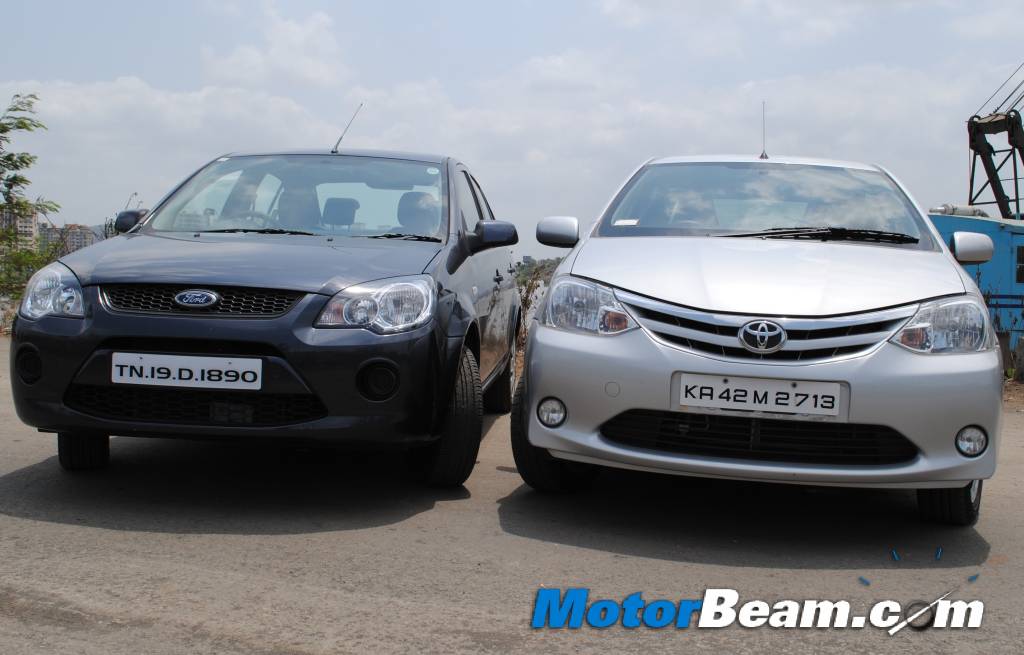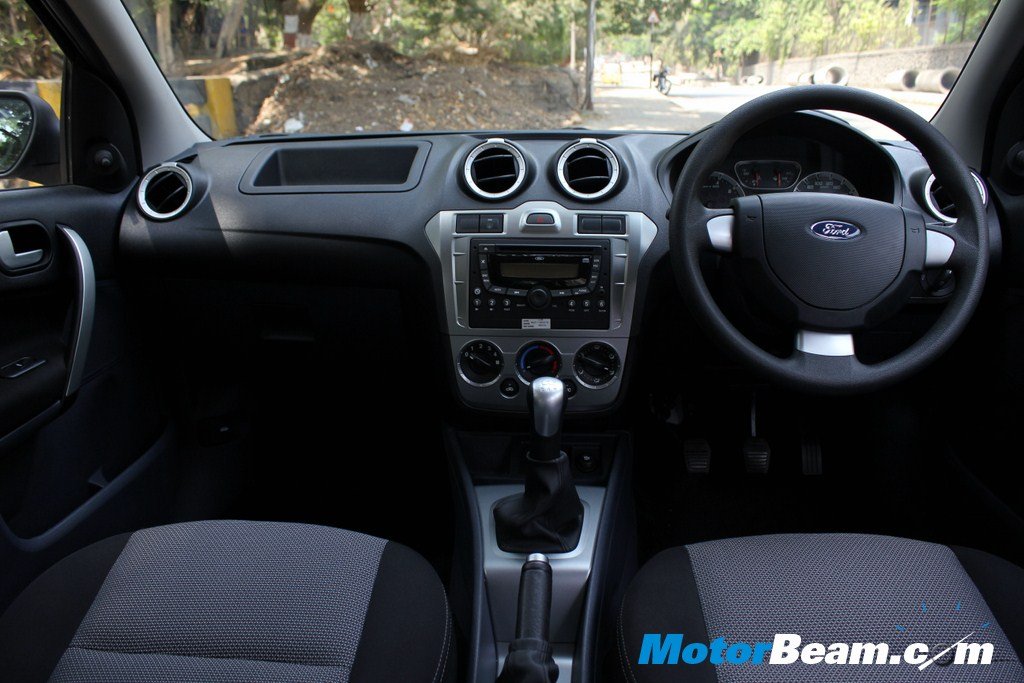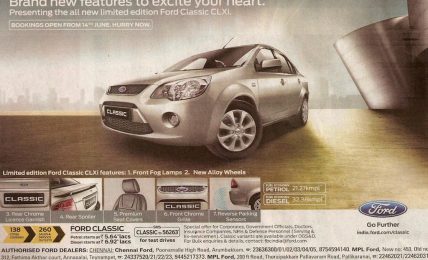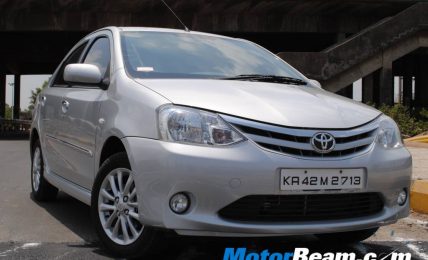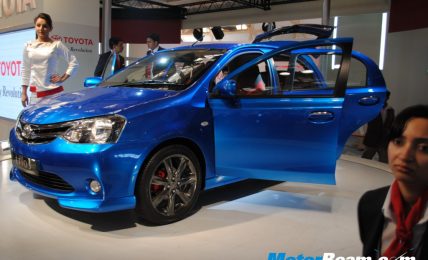Shootout – Ford Classic vs Toyota Etios
When it comes to entry level sedans, there are a very few choices. While Maruti Suzuki’s Swift DZire sells the most in the segment, it commands a huge waiting period and offers a very small boot. The Ford Classic and Toyota Etios are two of the most under-rated cars in the C-segment. Both the Ford Classic and Toyota Etios have a lot to offer but put together, they sell less than half of what the DZire manages alone. If you are in the market for an entry level sedan, which one would should you choose between the Toyota Etios and the Ford Classic? Let’s find out.
[flickr size=”center” float=”medium”]http://www.flickr.com/photos/motorbeam/7806683404/[/flickr]
While the Toyota Etios is much younger in terms of the design (the Etios was designed around 3-years back, while the Classic was designed almost 10 years ago), in terms of styling, the Classic looks much better than the Etios. The Ford Classic won’t attract attention like the fluidic Hyundai Verna, but in front of the bland looking Toyota Etios, the Classic looks very good. The boxy appearance of the Etios makes it very plain-Jane. Toyota has tried to spruce things up with the use of chrome but that doesn’t seem to help much.
On the interiors side, both cars are very different. The quality of interiors in the Etios is very un-Toyota like, with plastic quality far from being the best in the segment. Cost cutting is very evident and the Etios doesn’t feel well put together. The Classic on the other end, has excellent built quality and feels well put together. The doors shut with a assuring thud, while the Etios’ doors are flimsy. The lighter shade of the Etios interiors gives it an airy feeling, while the all black theme (with silver inserts) gives the Classic’s cabin a more mature feel. The centrally mounted instrument cluster in the Etios is not to our tastes and is very distracting.
[singlepic id=6044 w=540 h=375 float=center]
What the Toyota Etios lacks in quality and fit and finish, it pulls back strongly over the Ford Classic in terms of interior room. The Ford’s rear seats lacks legroom and under thigh support. The Etios on the other end offers excellent amount of legroom for rear seat passengers. The Etios can carry five full-sized adults in comfort, while the Classic is more suited for kids at the rear. The Etios can also swallow more luggage than the Classic, with a boot that can accommodate 595-litres against the Classic’s 430-litres.
[flickr size=”center” float=”medium”]http://www.flickr.com/photos/motorbeam/7806682044/[/flickr]
When it comes to petrol power, the 1.5-litre engine in the Toyota Etios produces 89 BHP at 5600 RPM and 132 Nm at 3000 RPM. The 1.6-litre petrol engine in the Ford Classic produces 101 BHP at 6500 RPM and 146 Nm at 3400 RPM. Both cars use a 5-speed manual transmissions which offer smooth shifts. Even with the extra power on tap, the Classic is not too significantly quicker than the Etios. The Classic is one of the fastest accelerating petrol cars in its segment but the Etios’ short gearing and lower weight helps it keep up with the Classic.
[flickr size=”center” float=”medium”]http://www.flickr.com/photos/motorbeam/7806682462/[/flickr]
When it comes to diesel engines, both cars have almost similar power output. The Ford Classic uses a 1.4-litre DuraTorq motor to pump out 68 BHP at 4000 RPM and 160 Nm at 2000 RPM. The Toyota Etios uses a 1.4-litre D-4D engine to generate 67 BHP at 3800 RPM and 170 Nm at 1800 RPM. Both cars offer excellent driveability with minimal turbolag. Gearshift quality is good in both the diesel engined vehicles. In terms of mileage, the petrol Etios offers slightly better mileage, while in case of diesel, its the Classic which edges ahead slightly.
[flickr size=”center” float=”medium”]http://www.flickr.com/photos/motorbeam/7806683190/[/flickr]
Both cars have good dynamics but the Fiesta edges ahead with sharper handling, good steering feedback and better high speed stability. The Etios has a very light steering, which is a boon in city conditions but vague at speed. The low weight also results in the Etios not being glued to the road at triple digit speeds. Ride quality of both cars is very good, with slight stiffness at low speed. Both cars have a turning radius of 4.9-meters which makes them easy to maneuver in crowded city traffic. Braking performance is on par with good stopping power.
[flickr size=”center” float=”medium”]http://www.flickr.com/photos/motorbeam/7806681706/[/flickr]
The Toyota Etios range starts at Rs. 6.50 lakhs for the base petrol J variant and goes up to Rs. 9.49 lakhs for the top end VX-D diesel variant. The Ford Classic range starts at Rs. 6.71 lakhs for the base petrol LXi variant and goes up to Rs. 9.49 lakhs for the top end diesel Titanium variant. Equipment levels are almost similar in both the cars. The petrol Classic is cheaper than the petrol Etios by a considerable amount, while the top end diesel variants are priced the same. The Etios also suffers from the taxi image.
If you want a practical vehicle (more space, big boot, better resale value), the Toyota Etios is for you. But if you want a vehicle which will put a smile on your face every time you take the wheel, the Ford Classic should be your choice. Better quality, superior driving dynamics, fantastic engines and excellent mileage put the Ford Classic ahead of the Toyota Etios in this shootout.
Further Reading –
Ford Classic Test Drive Review
Toyota Etios Test Drive Review


